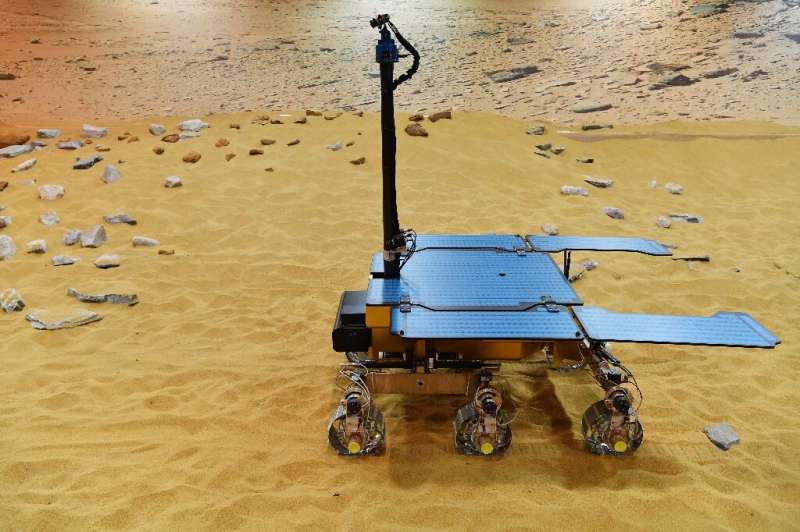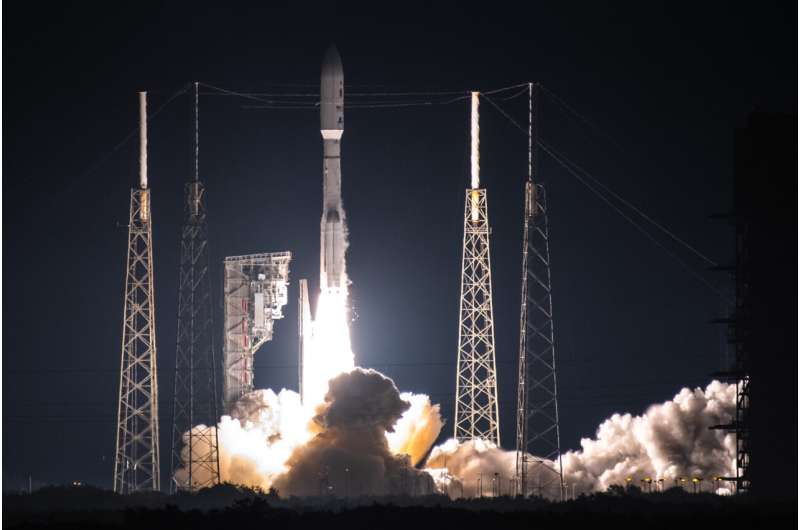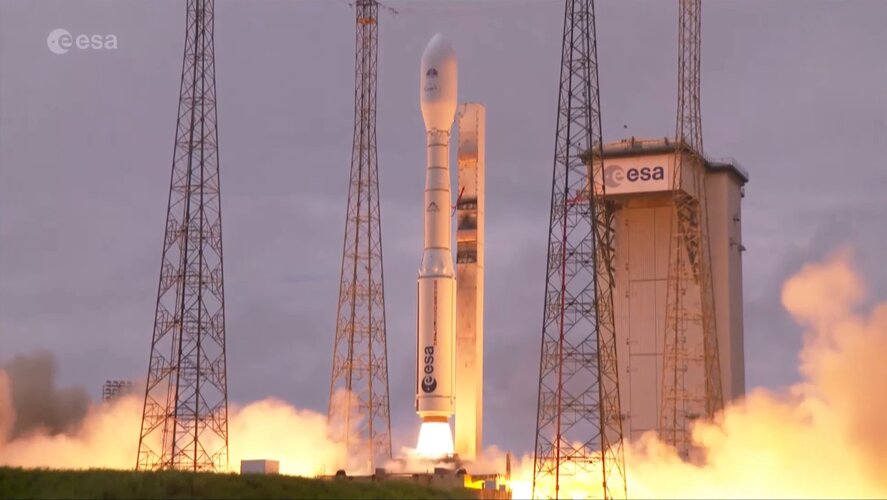
Copernical Team
Moving Right Along - Sol 3531
 Since we finished up with our "Avanavero" drill activities yesterday, we're officially back on the Martian road to the layered sulfate-bearing unit! Today we just planned a single sol's worth of activities, and filled the day with contact science, remote sensing, and a 50m+ drive.
The remote sensing and contact science activities include a MAHLI and ChemCam LIBS observation of a bedrock ta
Since we finished up with our "Avanavero" drill activities yesterday, we're officially back on the Martian road to the layered sulfate-bearing unit! Today we just planned a single sol's worth of activities, and filled the day with contact science, remote sensing, and a 50m+ drive.
The remote sensing and contact science activities include a MAHLI and ChemCam LIBS observation of a bedrock ta NASA Highlights Climate Research on Cargo Launch, Sets Coverage
 NASA and SpaceX are targeting 8:44 p.m. EDT Thursday, July 14, to launch the agency's next investigation to monitor climate change to the International Space Station. The mission, NASA's Earth Surface Mineral Dust Source Investigation (EMIT), will fly aboard SpaceX's 25th commercial resupply services mission to the orbital laboratory.
SpaceX's Dragon spacecraft will lift off from Launch Co
NASA and SpaceX are targeting 8:44 p.m. EDT Thursday, July 14, to launch the agency's next investigation to monitor climate change to the International Space Station. The mission, NASA's Earth Surface Mineral Dust Source Investigation (EMIT), will fly aboard SpaceX's 25th commercial resupply services mission to the orbital laboratory.
SpaceX's Dragon spacecraft will lift off from Launch Co Skyrora opens UK's largest rocket engine manufacturing facility
 UK rocket company Skyrora has taken another important stride towards achieving a sovereign orbital launch from British soil by opening a new manufacturing and production facility, the largest of its kind in the UK.
After recently opening its engine test facility in Midlothian, this new facility in Cumbernauld allows the company to concentrate its launch development practices in custom-buil
UK rocket company Skyrora has taken another important stride towards achieving a sovereign orbital launch from British soil by opening a new manufacturing and production facility, the largest of its kind in the UK.
After recently opening its engine test facility in Midlothian, this new facility in Cumbernauld allows the company to concentrate its launch development practices in custom-buil Short space trips for paying passengers on the way
 CAS Space, a Beijing-based rocket company owned by the Chinese Academy of Sciences, is designing a set of reusable rocket and spacecraft, with the aim of sending paying passengers on short trips into space, said the company's chairman.
Yang Yiqiang, a senior rocket scientist and founder of CAS Space, told China Daily in an exclusive interview on Wednesday that if everything goes according
CAS Space, a Beijing-based rocket company owned by the Chinese Academy of Sciences, is designing a set of reusable rocket and spacecraft, with the aim of sending paying passengers on short trips into space, said the company's chairman.
Yang Yiqiang, a senior rocket scientist and founder of CAS Space, told China Daily in an exclusive interview on Wednesday that if everything goes according Vega-C completes inaugural flight
 Flight VV21 lifted off from Europe's Spaceport in French Guiana at 15:13 CEST on Wednesday 13 July (14:13 BST/10:13 Kourou local time). This mission lasted about 2 hours and 15 minutes from liftoff to release of final payload and final burn of the AVUM+ upper stage engine.
Total payload mass at liftoff was approximately 474 kg: 296 kg for LARES-2, with the remainder being the six CubeSats,
Flight VV21 lifted off from Europe's Spaceport in French Guiana at 15:13 CEST on Wednesday 13 July (14:13 BST/10:13 Kourou local time). This mission lasted about 2 hours and 15 minutes from liftoff to release of final payload and final burn of the AVUM+ upper stage engine.
Total payload mass at liftoff was approximately 474 kg: 296 kg for LARES-2, with the remainder being the six CubeSats, Europe's upgraded Vega space launcher makes inaugural flight

ESA fully cuts Mars mission ties with Russia, angering Moscow

The European Space Agency has officially terminated cooperation with Russia on a mission to put a rover on Mars, with Russia's space chief furiously responding by banning cosmonauts on the ISS from using a Europe-made robotic arm.
The ESA had previously suspended ties on the joint ExoMars mission, which had planned to use Russian rockets to put Europe's Rosalind Franklin rover on the red planet to drill for signs of life, due to Russia's invasion of Ukraine.
ESA Director-General Josef Aschbacher tweeted on Tuesday that because the war and resulting sanctions "continue to prevail", the agency would "officially terminate" ties with Russia on ExoMars and its landing platform.
The firebrand head of Russian space agency Roscosmos Dmitry Rogozin issued an angry response.
"Has the head of the European Space Agency thought about the work of thousands of scientists and engineers in Europe and Russia which has been ended by this decision? Is he prepared to answer for sabotaging a joint Mars mission?" Rogozin said on Telegram.
SIRI-2 to qualify technologies for radiation detection in space

U.S. Naval Research Laboratory scientists launched the second Strontium Iodide Radiation Instrument (SIRI-2) instrument in December 2021 onboard Space Test Program (STP) Sat-6. SIRI-2, a gamma-ray spectrometer, will demonstrate the performance of europium-doped strontium iodide gamma ray detection technology with sufficient active area for Department of Defense (DoD) operational needs.
The first SIRI mission was launched Dec.
Space weather will delay your trains

Fluctuations in space weather are disrupting train signals and causing significant delays. A project investigating the effect of solar storms on railway signals will be presented this week at the National Astronomy Meeting (NAM 2022) by Cameron Patterson, a Ph.D. student at Lancaster University.
The sun's tendency to affect technology on Earth, as well as in space, is known as space weather. In railways, electric currents caused to flow in the Earth by solar activity can interfere with the normal operation of signals, turning green signals to red even when there is no train nearby.
Patterson says: "Most of us have at one point heard the dreaded words: 'your train is delayed due to a signaling failure,' and while we usually connect these faults to rain, snow and leaves on the line, you may not have considered that the sun can also cause railway signals to malfunction.
Vega-C liftoff
 Video:
00:06:42
Video:
00:06:42
Flight VV21 clears the launch pad to begin the inaugural mission of ESA’s new Vega-C rocket from Europe’s Spaceport in French Guiana.
